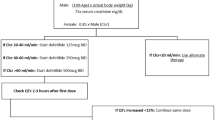Conclusion
The Harrison modification of the Vaughn Williams classification scheme for Class I antiarrhythmic drugs has been widely accepted. It has important clinical and electrophysiological bases, and recent membrane classification based on tightness of drug coupling to sodium channels in cardiac muscle and His-Purkinje tissue further supports the modification. This scheme enables the clinician to predict appropriate agents for patients with particular arrhythmia syndromes and to effectively combine drugs to treat life-threatening arrhythmias. As new drugs are tested and classified, it should continue to prove useful to electrophysiologists and arrhythmia specialists in the future.
Similar content being viewed by others
References
Campbell TJ. Kinetics of onset of rate dependent effects of Class I drugs are important in determining their effects on refractoriness in guinea-pig ventricle and provide a basis for their subclassification. Cardiovascular Research 17: 344–352, 1983
Harrison DC (Ed.). Symposium on perspectives on the treatment of ventricular arrhythmias. American Journal of Cardiology 52: IC–2C, 1983
Harrison DC. Antiarrhythmic drug classification: new science and practical applications. American Journal of Cardiology 56: 185–187, 1985
Harrison DC, Winkle RA, Sami M, Mason JW. Encainide: a new and potent antiarrhythmic agent. In Harrison (Ed.) Cardiac arrhythmias: a decade of progress, pp. 315–330, G.K. Hall Medical Publishers, Boston, 1981
Keefe DLD, Kates RE, Harrison DC. New antiarrhythmic drugs: their place in therapy. Drugs 22: 363–400, 1981
Vaughn Williams EM. Classification of antiarrhythmic drugs. In Sandoe et al. (Eds) Cardiac arrhythmias, pp. 449–473, Ad Astra, Sodertalje, Sweden, 1970
Vaughn Williams EM. Disopyramide. In Garfein (Ed.) Clinical pharmacology of cardiac antiarrhythmic agents: classical and current concepts reevaluated. Annals of the New York Academy of Sciences 432: 189–200, 1984
Author information
Authors and Affiliations
Rights and permissions
About this article
Cite this article
Harrison, D.C. Current Classification of Antiarrhythmic Drugs as a Guide to Their Rational Clinical Use. Drugs 31, 93–95 (1986). https://doi.org/10.2165/00003495-198631020-00001
Published:
Issue Date:
DOI: https://doi.org/10.2165/00003495-198631020-00001




